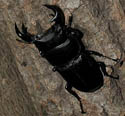|
In most museums I've seen with displays on Medieval and Renaissance armor, you see a lot of ornately designed parade and festival armor, which while impressive looking, doesn't seem terribly practical for actual combat, (the giant protruding animal or monster faces from the faceplates of grotesque armor, for example). What would an upper-class (who could afford to buy custom-made armor) wear to a real battle, and how would the decorative details differ from the armor for show? Or did they actually wear those fancy armors in battle?
|
|
|
|

|
| # ¿ Apr 29, 2024 01:03 |
|
How exactly did one go about fighting with a mace? It seems like a weapon very heavily skewed towards offense at the expense of defense, even if they were nowhere near as heavy as depicted in fiction. A Buttery Pastry posted:There is of course always the possibility of it being "Chinese" (at times). Geographical confusion about where stuff came from is not that unusual. Chinese cinnamon is for example also native to India, Bangladesh and Vietnam, which might mean it was imported by Arab traders sailing the Indian Ocean and not through the Silk Road. Incidentally, I found out that Chinese cinnamon (less delicate and cheaper, thus known as bastard cinnamon) is the preferred cinnamon in the US and Canada, sold simply as just cinnamon, while the more delicate Ceylon cinnamon (known as true cinnamon Chinese cinnamon, or cassia, though is pretty distinctive in appearance (as long as it's not already ground into a powder), when compared to True cinnamon. True cinnamon sticks are made up of multiple layers of thin, light brown bark, whereas a stick of cassia is made of a very thick single layer of reddish brown bark.
|
|
|
|
DandyLion posted:'Sword and Board' was only realistic in the context of non-plate armor. Once plate armor came onto the scene in force the only instances where you would likely see them carrying shields was in sieges and other specialized cases. This is one thing that bugs me to no end about modern interpretations of armored combatants. Plate armor protected you just as well as a shield, so why carry the extra weight and additional hand encumbrance? Would plate armor protect just as well as a shield in the case of flanged maces and warhammers, though?
|
|
|
|
Baldbeard posted:The only way the impact energy is similar is if the strike lands exactly where your arm is supporting the shield. Even if that were to happen, you would still be better off with a hammer or whatever denting your shield rather than denting your armor section with body under it. Plus shields are angled to deflect blows in ways that you aren't going to do with your arms or elbows. I was also thinking that even if the metal didn't crush the flesh underneath, if the blow lands on a joint and deforms it, the joint may stick. If this happens to your elbow or shoulder, your ability to defend and attack would be compromised. If this happens to your leg or pelvis, your mobility goes. If both, you're basically sitting in a shiny custom fitted coffin. I don't know how closely fitted those armor joints were, but making them too loose fitting would seem like a bigger invitation for a thrust from a spear or sword. If really close fitting, I would think that even some glancing blows might be dangerous. Seems like a horrifying way to go; a few blows from a mace, and you're stuck in a suit of armor, unable to move or defend yourself, waiting to die inside a tiny metal prison.
|
|
|



